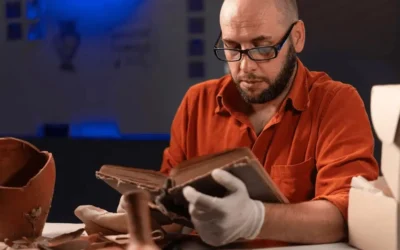Disaster and Preservation Planning for Archives
Margot Note
Most archivists recognize that they need to plan for disasters, yet many repositories never conduct proper emergency and preservation planning. Even if they do develop a plan, it often is never updated or utilized.
The lack of foresight is due in part to the complexity of disaster planning, which involves many people, offices, and facilities outside of the archives department. In addition, archivists often work in understaffed and underfunded repositories, focused on the day-to-day operational activities. They may not have the opportunity to strategically plan for the worst—until it’s too late.
Creating a Disaster Plan
The first action in creating a disaster plan is to identify risks. Archivists should look at the risks to their collections in terms of building issues, such as the site terrain, if the basement is above the flood line, electrical and plumbing issues, heating, ventilation, and air conditioning (HVAC) systems, the roof, and fire suppression systems.
It’s also essential to set priorities. Of course, people come first. Then, identify objects that would be vulnerable to threats. Archivists should review collections to determine the valuable objects that they hold.
Consider how to decrease risks. The best protection for archival materials is a cool, dry, and stable environment of moderate temperature and relative humidity with little fluctuation. Clean air and air circulation, no natural or fluorescent light, and good housekeeping are also necessary. Routine building inspections, shifting materials to other locations, regular maintenance and repair schedules, the installation of fire suppression systems, better recordkeeping, improved housekeeping procedures, and other security measures should be reviewed. The off-site storage of vital records or their surrogates and data backups provide business continuity during and after an emergency.
In addition, regular institutional routines with cooperation among the different units of the institution need to integrate planning. The departments must address all kinds of potential emergencies that could happen at the repository.
Next, identify and secure resources. Supplies such as drop cloths, sponges, flashlights, rubber gloves, mops, and buckets should be stored in a marked location. Create an easily accessible list of emergency numbers for both staff members and outside vendors that could help. Reach out for other technical assistance, such as a contract with a freeze-dry company in case flooding happens.
Writing the Disaster Plan
Disaster, response, and recovery plans often contain different information for different scenarios.
A plan should contain the following elements:
- Introduction
- Actions to be taken if there’s an advance warning
- First response procedures, such as who to contact when problems arise
- Emergency procedures
- Rehabilitation plans for getting the repository back to normal after a disaster and prioritizing materials for treatment
- Appendices including telephone numbers of employees and recovery services, alarms, locations of keys, floor plans, insurance information, priorities, and other essential information
After the plan is written, it must be maintained and updated, as necessary. People should be aware of where the plan is. A copy should be stored offsite, with signs relaying contact information and emergency responses. A preservation officer for the repository should be appointed.
Preservation Planning
At the same time as disaster planning, it’s wise to plan for preservation risks to the collection. Calculate the risks to the collections by gathering reliable data through tools such as surveys related to object conditions, the environment, and protective systems and practices. Also, consider how the staff can perform preventive preservation.
Determine the value of the collections, especially the breadth and depth of the holdings. Archivists should identify valuable items or those at risk.
Once those activities are completed, archivists should identify available resources, based on the information gathered on the condition of collections, the environment, factors related to the housings of the materials, and the value of collections.
Plan Ahead
Archivists should take the time to become informed on disaster planning, response, and recovery, as well as necessary preservation needs—before an emergency strikes. Recovering from and mitigating the impact of an unexpected interruption of operations requires forethought to develop policies and procedures, but that effort is well-invested for the sustainability of the historical record.
Margot Note
Margot Note, archivist, consultant, and author is a guest blogger for Lucidea, provider of ArchivEra, archival collections management software for today’s challenges and tomorrow’s opportunities. Read more of Margot’s posts here, and get your free copy of Margot’s book under the Lucidea Press imprint, Demystifying Archival Project Management: Five Essentials for Success
Similar Posts
Texas Archive of the Moving Image: Interview with the Digital Archivist
I recently interviewed Grace Muñoz about her work at the Texas Archive of the Moving Image. Her work on improving the discoverability of the multimedia collection is fascinating.
How to Conduct Comprehensive Archival Surveys
Conducting a comprehensive archival survey is critical to successfully managing archival collections.
Remembering History, Moving Forward Together, with ArchivEra
The Catholic Diocese of Arlington’s Director of Archives selected ArchivEra to manage their collections of historical and cultural significance, and strike a balance between security and access.
Unveiling Archival Impact
The transformative power of storytelling depends upon the strategic choices that top archival performers make and the shift from being record-keepers to change agents.




Leave a Comment
Comments are reviewed and must adhere to our comments policy.
0 Comments